Dennis Chalker | |
|---|---|
| Nickname(s) | Denny, Snake |
| Born | July 28, 1954 Mantua, Ohio |
| Allegiance | United States of America |
| Service/ | United States Army United States Navy |
| Years of service | 1971–1975 1977-1998 |
| Rank | Command Master Chief Petty Officer |
| Other work | CEO of DSC Inc. and Director of Operations for GSGI, author |
Dennis Chalker (born July 28, 1954) is a retired Navy SEAL, inventor and author who has written six books about the United States Navy SEALs.
Chalker began his military service with the U.S. Army, serving in the 82nd Airborne Division from 1972 till 1975. Upon discharge he tried his hand at a few civilian jobs and found them less than challenging. Chalker then joined the United States Navy in 1977. Chalker graduated from Basic Underwater Demolition/SEAL (BUD/S) training Class 101 in Coronado, Ca and became a Navy SEAL. Chalker initially served with SEAL Team One and was later hand-selected by Commander Richard Marcinko in 1980 to become a plankowner of the Navy's first dedicated counter-terrorist unit, SEAL Team Six. As a member of SEAL Team Six, he participated in Operation Urgent Fury in the US Invasion of Grenada. His team reached then Governor General Paul Scoon's mansion and held it for an entire day while being attacked by a force of Grenadians and Cubans. [1]
As a SEAL, Chalker saw action in Haiti (recounted in his book One Perfect Op), El Salvador, and Panama. [2] [1] [3]
When Marcinko was tasked to select members for a new unit to test security at US Naval bases against the threat of terrorism, he once again chose Chalker as one of the founding members in 1985. This unit was called Naval Security Coordination Team, also known as Red Cell. [2] Chalker transitioned back to SEAL Team SIX in 1987 which was renamed as Naval Special Warfare Development Group. His final duty station was as the Command Master Chief at the Naval Special Warfare Center for BUD/S (Basic Underwater Demolition/SEALs) Training in Coronado, California. While serving as Command Master Chief of BUD/S, Chalker was hired as a technical advisor for The Rock , a 1996 Jerry Bruckheimer film. [2] Chalker was also used as an onscreen extra during the movie's swim and dive sequences. [2] [1] This led to a position as Director of Operations with Global Studies Group, Inc. (GSGI), upon his retirement from the US Navy. [4] GSGI is a combination security and training company owned by former US Navy SEAL Harry Humphries that specializes in bringing modified (civilian version) SpecOps tactical skill training to law- enforcement agencies and Hollywood movie productions. [4] Chalker is credited for inventing and developing a tactical rifle and submachine gun single-point sling known as the Chalker Sling while at SEAL Team Six. The Chalker Sling attaches the long gun to the shooter via a harness which enables the operator to quickly transition to a secondary weapon or perform another task while using both hands and keeping the weapon in a close-ready position as the weapon "hangs" from the chest, leaving just enough slack to be able to quickly bring it to firing position with little effort. [1]
Since retiring from the Navy, Chalker has authored six books, three fiction and three non-fiction with Kevin Dockery about life as a Navy SEAL.

The United States Navy Sea, Air, and Land (SEAL) Teams, commonly known as Navy SEALs, are the U.S. Navy's primary special operations force and a component of the Naval Special Warfare Command. Among the SEALs' main functions are conducting small-unit special operation missions in maritime, jungle, urban, arctic, mountainous, and desert environments. SEALs are typically ordered to capture or to kill high level targets, or to gather intelligence behind enemy lines.

Rudolph Ernst Boesch was a United States Navy SEAL, and two-time competitor on the reality competition show Survivor.

The United States Naval Special Warfare Command (USNSWC), also known as, is the naval component of United States Special Operations Command, the unified command responsible for overseeing and conducting the nation's special operations and missions.

The Special Warfare insignia, also known as the "SEAL Trident" or its popular nickname in the Navy community, "The Budweiser", recognizes those members of the United States Navy who have completed the Basic Underwater Demolition/SEAL (BUD/S) training, completed SEAL Qualification Training (SQT) and have been designated as U.S. Navy SEALs. It is one of the most recognizable breast insignias of the U.S. Navy.
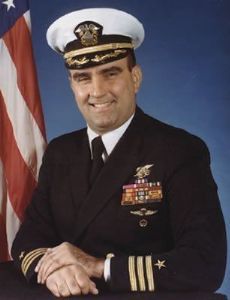
Richard Marcinko was a U.S. Navy SEAL commander and Vietnam War veteran. He was the first commanding officer of SEAL Team Six. After retiring from the United States Navy, he became an author, radio talk show host, military consultant, and motivational speaker.

Lupara is an Italian word used to refer to a sawed-off shotgun of the break-open type. It is traditionally associated with Cosa Nostra, the Italian organized crime group dominant in Sicily for their use of it in vendettas, defense — such as its use against Benito Mussolini's army when he decided to break up the Sicilian mafioso network—and hunting.
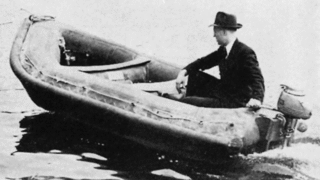
The LCRS was a small inflatable boat which was used by the United States Navy and USMC from 1938 to 1945. During World War II 8,150 LCRSs were made. It had a weight of 95 kg and could transport seven men.

Ernest R. Emerson is an American custom knifemaker, martial artist, and edged-weapons expert. Originally an engineer and machinist in the aerospace industry, Emerson became a knifemaker by producing knives for a martial arts class and making art knives early in his knifemaking career. In the 1980s he became better known for his combat knives and popularizing a style of knife known as the Tactical-folder.

Thomas Rolland Norris is a retired United States Navy SEAL and Distinguished Eagle Scout who received the Medal of Honor for his ground rescue with the assistance of Petty Officer Third Class Nguyen Van Kiet of two downed aircrew members in Quang Tri Province, Vietnam on April 10–13, 1972. At the time of the action, Lieutenant Norris was a SEAL Advisor with the Strategic Technical Directorate Assistance Team. Norris was one of three SEALs to receive the Medal of Honor for actions during the Vietnam War.

Michael Edwin Thornton is a retired United States Navy SEAL and recipient of the U.S. military's highest decoration, the Medal of Honor, for his actions in the Vietnam War. He was awarded the medal for saving the life of his senior officer, Lieutenant Thomas R. Norris, who also earned the Medal of Honor in an unrelated incident.

Roy H. Boehm was born in Brooklyn, New York and was a veteran of 30 years of military service in the United States Navy, serving in three wars and various clandestine operations. Boehm was a mustang officer who rose up from the enlisted ranks and was commissioned to develop and lead what would become the US Navy SEALs as the first Officer In Charge of SEAL Team Two.
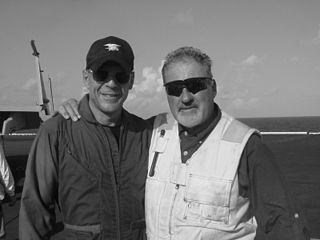
Harry R. Humphries is a former United States Navy SEAL who currently works as a consultant and actor on Hollywood films. After graduating from Admiral Farragut Academy and attending Rutgers University in New Jersey, Humphries joined the Navy, where he was assigned to UDT 22 and SEAL Team 2. In 1971, Humphries left the Navy with an Honorable Discharge. After a career with Henkel KGaA, the German Multi National Chemical Company, he moved to California, where he started Global Study Group, Inc. ("GSGI"). Humphries currently resides in Huntington Beach, California where he works full-time as a Security Consultant and Entertainment Technical Adviser/Actor.
Kevin Dockery is an American fiction and nonfiction author and military historian. He is best known for his work detailing the history and weapons of the Navy SEALs. He served in the US Army on the President's Guard, and as an armorer. Since retiring from the Army, he has worked as a curator for the SEAL Museum in Fort Pierce, Florida, an historian, a game designer and as a lecturer. He has written 37 books, appeared in a number of television documentaries and served as technical advisor for several motion pictures.
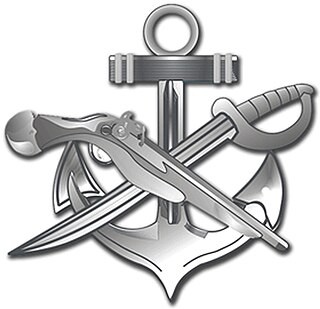
The Special Warfare Combatant-craft Crewmen is a United States Naval Special Warfare Command team that operates and maintains small craft for special operations missions, particularly those in support of the U.S. Navy SEALs.

The CQC-6 or Viper Six is a handmade tactical folding knife with a tantō blade manufactured by knifemaker Ernest Emerson. Although initially reported as the sixth design in an evolution of fighting knives and the first model in the lineup of Emerson's Specwar Custom Knives, Emerson later revealed that the knife was named for SEAL Team Six. It has a chisel-ground blade of ATS-34 or 154CM stainless steel and a handle made of titanium and linen micarta. The CQC-6 is credited as the knife that popularized the concept of the tactical folding knife.
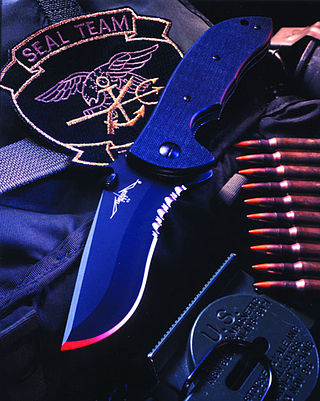
The Commander (knife) is a large recurve folding knife made by Emerson Knives, Inc. that was based on a custom design, the ES1-M, by Ernest Emerson that he originally built for a West Coast Navy SEAL Team. It was winner of the Blade Magazine Overall Knife of the Year Award for 1999.
Mad Dog Knives is a custom knifemaking facility headed by Kevin McClung, a former Senior Materials Scientist at the American Rocket Company, Mad Dog Knives is based in Prescott, Arizona. Mad Dog Knives made the fixed-blade knife known as the ATAK, used by Naval Special Warfare Groups 1 and 2 after the "SEAL Trials" of 1992. Mad Dog Knives are typically made from selectively tempered, hand ground O1 Tool Steel with a hardchrome plating to protect the blade.

The average member of the United States Navy's Sea, Air, Land Teams (SEALs) spends over a year in a series of formal training environments before being awarded the Special Warfare Operator Naval Rating and the Navy Enlisted Classification (NEC) O26A Combatant Swimmer (SEAL) or, in the case of commissioned naval officers, the designation 113X Special Warfare Officer. All Navy SEALs must attend and graduate from their rating's 24-week "A" School known as Basic Underwater Demolition/SEAL (BUD/S) school, a basic parachutist course and then the 26-week SEAL Qualification Training program.

The Naval Special Warfare Development Group (NSWDG), abbreviated as DEVGRU and commonly known as SEAL Team Six, is the United States Navy component of the Joint Special Operations Command (JSOC). The unit is often referred to within JSOC as Task Force Blue. DEVGRU is administratively supported by Naval Special Warfare Command and operationally commanded by JSOC. Most information concerning DEVGRU is designated as classified, and details of its activities are not usually commented on by either the United States Department of Defense or the White House. Despite the official name changes, "SEAL Team Six" remains the unit's widely recognized moniker.